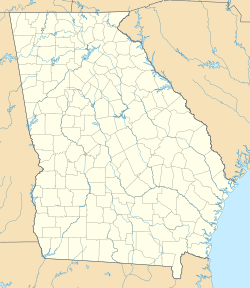Punk Rock Shelter facts for kids
| Location | Putnam County, Georgia, |
|---|---|
| Region | Putnam County, Georgia |
| Coordinates | 33°23′29.51″N 83°11′21.59″W / 33.3915306°N 83.1893306°W |
| History | |
| Cultures | South Appalachian Mississippian culture |
| Site notes | |
| Excavation dates | 1978 |
The Punk Rock Shelter (also known as 9PM211) was an important archaeological site located in Putnam County, Georgia. Sadly, it was flooded in 1979 and now rests about 65 feet (20 meters) underwater in Lake Oconee.
Even though it's called a "rock shelter," it wasn't a typical cave. Instead, it was a natural area formed by a pile of large granite boulders. Over time, due to farming practices in the 1800s and 1900s, the original ground level of the shelter became buried under a thick layer of red clay and mud. The Native American people who used this site were most likely ancestors of the Hitchiti tribe.
Contents
How It Was Found
The Punk Rock Shelter was first discovered on November 15, 1974. Two people named Greg Paulk and Dean Wood found it. They were working on a project called the Wallace Reservoir Archaeological Survey at the time.
Digging Up the Past
Archaeologists began exploring the Punk Rock Shelter soon after its discovery.
- On November 18, 1974, John Doolin joined Greg Paulk and Chester DePratter. They dug a trench, which is a long, narrow ditch, to learn more about the site.
- A few days later, on November 20, Dean Wood and Chester DePratter returned to dig deeper into a "midden." A midden is like an ancient trash heap, full of things people threw away.
- The team continued to expand their digging area over the next few days. They carefully took photos and made drawings of everything they found.
The main excavation of the site happened later, from June 14 to August 10, 1978. This bigger dig was led by Mark Williams. His team expanded on the earlier work and found that the shelter was about 7.5 meters (24.6 feet) long and 4.5 meters (14.8 feet) wide.
One of the most interesting things found during the dig was a large number of quartz pebbles. These pebbles were red and were often found near broken pieces of pottery. Mark Williams had learned from his past research that red quartz pebbles usually meant they had been heated by fire. This suggests they might have been used for indirect heating, perhaps by placing them in water to warm it up.
Dating the Site
By studying the pottery pieces found at the Punk Rock Shelter, archaeologists could figure out when people used the site. The pottery showed that the site was used during the Lamar and Savannah periods. These periods are part of the larger Mississippian Period in Native American history.
The Punk Rock Shelter is special because it's the only known site in the Oconee Valley with so much pottery from these specific time periods. The pottery found covers a long stretch of time, from about A.D. 1250 to A.D. 1650. This means people used the shelter consistently for about 400 years!
What Was the Shelter Used For?
The large amount of pottery pieces shows that the site was used many times over a long period. However, archaeologists found very few animal bones, plant remains (except for burnt wood), or tools made of stone. They also didn't find any signs of permanent buildings. This suggests that people probably didn't live there for long periods.
Mark Williams, the archaeologist who led the main dig, thought about six possible ways the Punk Rock Shelter might have been used:
- A normal place to live
- A place people lived in only during certain seasons
- An area where pottery was made
- A place near a spring
- A place where clay was collected
- A special "ceremonial" area
After his research, Williams believed the shelter was most likely used for ceremonies.
Ceremonial Uses
The exact type of ceremony that happened at the Punk Rock Shelter is still a mystery. No human remains or signs of cremation were found. However, Williams had some ideas. Even though the people at the site were Hitchiti, they shared many traditions with the Cherokee people.
The shelter was located between two important water sources: Riley Shoals and the Oconee River. Water was very important in Cherokee traditions. People might have gathered here to teach younger generations about the dangers of rivers and shoals.
Another idea is that the Punk Rock Shelter was used for sweat baths. Ceremonial sweat baths were important to the Cherokee for healing and religious experiences. The water-worn, red pebbles found at the site could have been heated up and used to create steam for these baths. Only a few animal skins would have been needed to keep the steam inside the shelter. The large rocks could have served as seats, or fires could have been built around them to heat them. Pottery vessels could have held hot water, and the nearby Oconee River would have been perfect for cooling off afterward.


